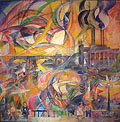THE UKRAINIAN MUSEUM PRESENTS
FUTURISM AND AFTER: DAVID BURLIUK, 1882-1967
ARTIST CONSIDERED THE FATHER OF RUSSIAN AND
UKRAINIAN FUTURISM
FIRST BURLIUK SURVEY OF ITS KIND IN THE UNITED STATES IN NEARLY HALF A CENTURY
2009 MARKS 100TH ANNIVERSARY OF THE BIRTH OF FUTURISM
October 31, 2008 – March 22, 2009
The Ukrainian Museum, New York City
Curated by Dr. Myroslav Shkandrij
Catalog
– Friday February 27, 2009 (7pm) Film: David Burliuk and the Japanese Avant-garde
Review/news coverage:
- New York Times, December 26, 2008, Showman Who Dabbled in Many Modernisms by Ken Johnson.
- Futurism and After: David Burliuk, 1882-1967 at the Ukranian Museum via Artdaily.org
- David Burliuk, the Ukrainian Father of Japanese Futurism via Artopia.com (John Perreault’s art diary)
This year marks the 100th anniversary of the birth of Futurism with the signing of F. T. Marinetti’s Futurist Manifesto. Futurism and After: David Burliuk, 1882-1967, a large-scale exhibition, with more than a hundred works along with photographs of the artist and some of his personal belongings, provides an overview of the most important periods in the life of famed Futurist David Burliuk.
…
The exhibition is the first major U.S. show of Burliuk’s art in nearly half a century. Internationally renowned as the father of Futurism in Russia and his native Ukraine, Burliuk was a major contributor to the seminal period of modernism in the early decades of the 20th century. He was the last living contributor to Germany’s Blaue Reiter Movement, one of the first modernist movements in art.
…
“Many of these works have not been exhibited in New York City so this is a unique opportunity to take a close and rare look at the whole career of one of 20th century’s important avant-garde artists through the prism of his own collection now in the possession of his granddaughter,” said Professor Jaroslow Leshko, President, The Ukrainian Museum, New York.
Futurism and After: David Burliuk, 1882-1967, is made possible by the generosity of Mary Clare Burliuk, the artist’s granddaughter, who lent works of art and archival material from her extensive personal collection.
…
David Burliuk was born in 1882 near the city of Kharkiv in eastern Ukraine. He studied in Odesa and Kazan, at the Munich Royal Academy of Arts (1902-1903), and at the École des Beaux-Arts in Paris (1904). His exuberant and extroverted character was recognized by Anton Azhbe, his professor at the Munich Academy, who called Burliuk a “wonderful wild steppe horse.”
…
Burliuk’s art during his historically important early period was an amalgam of Fauvist, Cubist, and Futurist influences, which he absorbed and melded with his love of nature, a fascination for the forms and designs of Scythian culture (he formed and named the literary-artistic group “Hylaea” – the Greek name for ancient Scythian lands), and especially his admiration for Ukrainian folklore. Among his favorites was the legend of Mamai, a Cossack who embodied Burliuk’s own vision of bravery, self-sufficiency, and rugged individualism.
During these years, Burliuk was an active participant in important avant-garde exhibitions in Kyiv, Moscow, St. Petersburg, and Munich. Dr. Shkandrij writes: “From December 1913 to April 1914, the notoriety of the Futurists reached its peak as Burliuk, [Vladimir] Maiakovsky, and [Vasily] Kamensky toured 17 cities in the Russian Empire. The appearance of the Futurists (they liked to wear gaudy waistcoats, sometimes painted animals on their faces and wore carrots in their lapels) and their ‘performances,’ which included drinking tea on stage under a suspended piano, drew packed audiences, scandalized many, but also won converts to the new art.” Burliuk’s life-affirming energy, his creative force, and his celebration of the new – all left a lasting impact on the history of modernism.
Burliuk’s art and life after his tumultuous early period would take him to many and varied places. During the revolutionary years 1917-1920, he traveled to Siberia, where he gave Futurist concerts and sold his art. From 1920 to 1922 he spent time in Japan painting, organizing exhibitions, and promoting Futurism. Ihor Holubizky writes in the exhibition catalogue: “Japanese modernist art history . . . has attached much greater significance to his stay in Japan [than have western accounts] and to the enthusiastic critical reception that he received there.” In 1922, Burliuk arrived in the United States, settling first in New York City, where he lived from 1922 to 1941, and then in Hampton Bays, Long Island (1941-1967).
The inspiration for Burliuk’s later career is found in his love of vitality in all its forms – biological, psychological, and cultural. Whether he was painting his native Ukrainian steppe, Japanese landscapes, Long Island fishing villages, or the streets of New York, he searched for the energy that vibrated and flowed through scenes. They suggest the existence of hidden patterns just beyond human perception.
“He was, in the end, a worshiper of the earth’s abundance and glory as much as a Futurist scandalizer of public taste,” notes Dr. Shkandrij. It is not surprising that one of his favorite artists was Vincent van Gogh, whose impassioned vision of nature, tendered with brilliant color and vigorous strokes, Burliuk admired greatly.
…
David Burliuk died on Long Island in 1967. That same year he was honored posthumously by being inducted into the American Academy of Arts and Letters. Examples of Burliuk’s work are in the collections of most major museums, among them the Metropolitan Museum of Art, the Museum of Modern Art, the Guggenheim Museum, the Whitney Museum, and the Brooklyn Museum in New York City; the Museum of Fine Arts in Boston; the Smithsonian American Art Museum in Washington, D.C.; the State Russian Museum in St. Petersburg; the National Art Museum in Kyiv; and the National Museum of Modern Art in Kyoto. His works are also included in numerous private collections.
